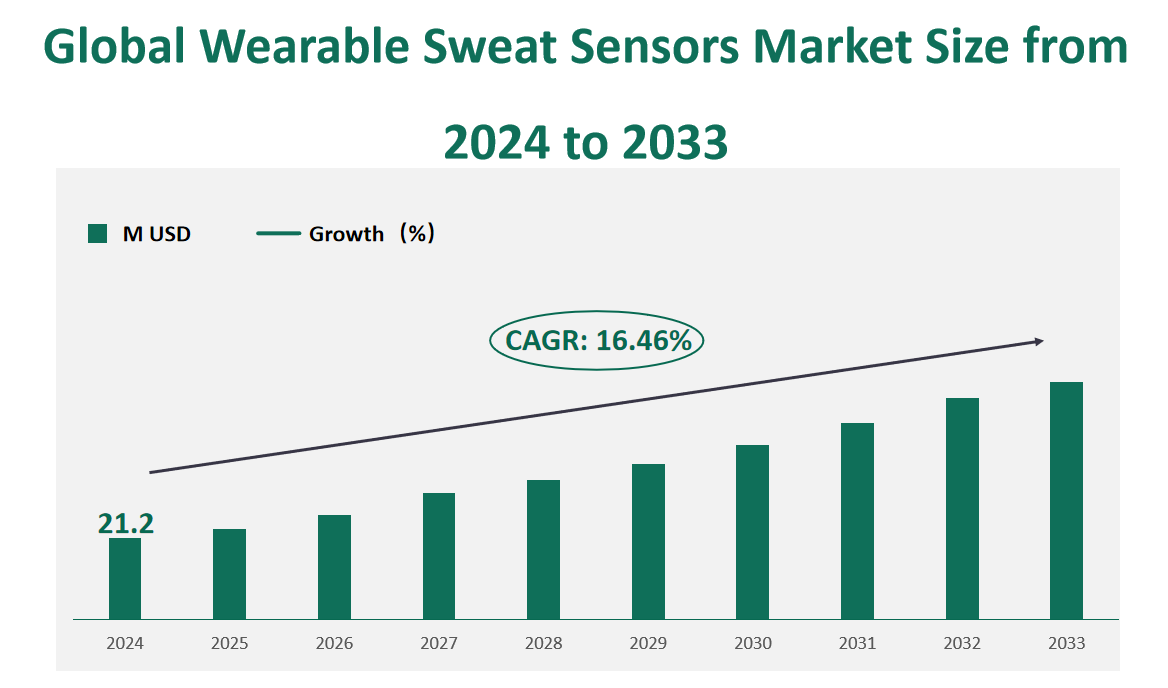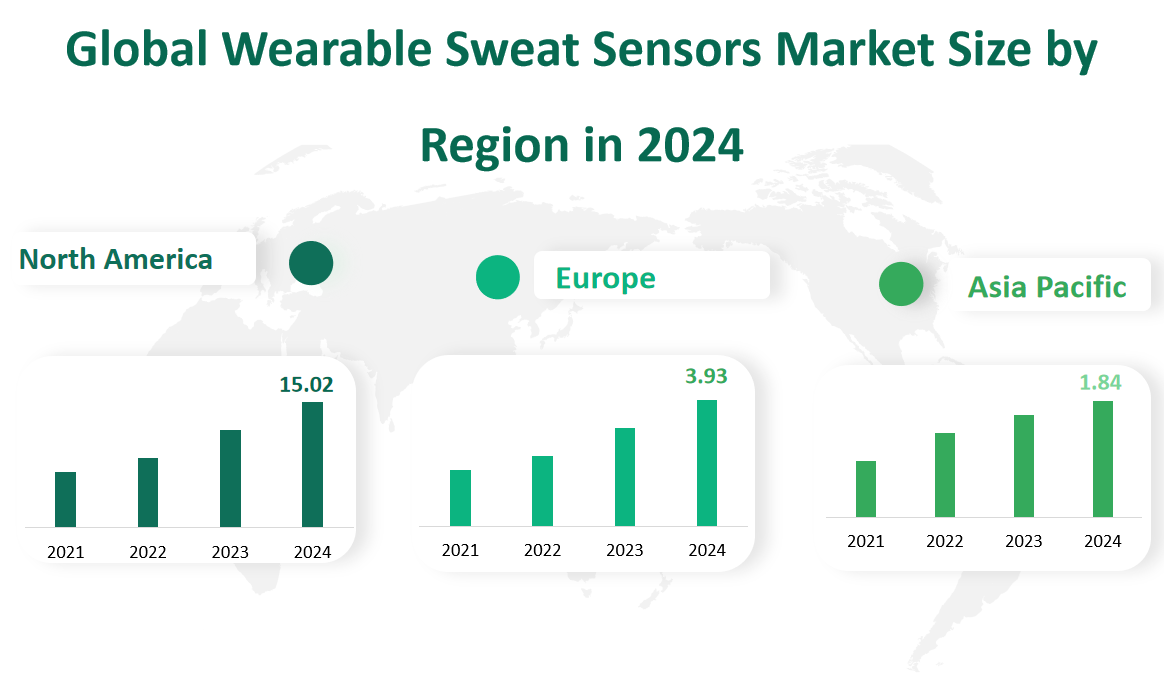1 Global Wearable Sweat Sensors Market Insight Analysis
The global Wearable Sweat Sensors Market is anticipated to experience significant growth in the coming decade. In 2024, the Wearable Sweat Sensors Market revenue is projected to be 21.20 M USD, with a CAGR of 16.46% from 2024 to 2033.
Wearable Sweat Sensors Market are advanced devices designed to monitor and analyze the composition of sweat, providing real-time, non-invasive health monitoring. These sensors detect various biomarkers in sweat, including electrolytes, metabolites, proteins, and other chemical compounds, offering insights into hydration levels, electrolyte balance, glucose levels, and other physiological states. The market’s growth can be attributed to the increasing awareness of personal health and the continuous advancement of wearable technology.
Figure Global Wearable Sweat Sensors Market Size (M USD) and CAGR (2024-2033)

2 Wearable Sweat Sensors Market Growth Drivers and Restraints
The increasing awareness about personal health and fitness has led to a surge in demand for devices that can monitor health metrics. Wearable sweat sensors, offering real-time data on hydration, electrolyte balance, and other vital signs, align perfectly with this trend.
Rapid advancements in sensor technology, material science, and data analytics have made wearable sweat sensors more accurate, reliable, and user-friendly. These technological leaps have expanded the potential applications of wearable sweat sensors in various fields, including sports, healthcare, and the military.
The rise of telemedicine and remote patient monitoring has created a need for devices that can provide continuous health tracking. Wearable sweat sensors meet this need by offering continuous, real-time monitoring of various health parameters.
Aging populations in many countries are leading to increased demand for health monitoring devices that can aid in the management of chronic diseases and promote independent living.
Professional athletes and sports teams are increasingly using wearable sweat sensors to optimize performance, hydration, and recovery, driving market growth in this segment.
The variability in sweat composition across individuals and even within the same individual under different conditions poses a significant technical challenge. Ensuring accurate and consistent readings despite these variations is a complex task.
As with any device that collects personal health data, wearable sweat sensors must address concerns about data security and privacy. Consumers are increasingly wary of how their data is stored, used, and protected.
The high cost of advanced sensor technology can make wearable sweat sensors expensive, limiting their accessibility to certain market segments. This cost barrier could slow market penetration.
There is a need for increased awareness and understanding of the benefits of wearable sweat sensors among both consumers and healthcare providers. Lack of awareness can hinder market growth.
3 Technological Innovations and Mergers in the Wearable Sweat Sensors Market
The wearable sweat sensors market is characterized by rapid technological innovation and active mergers and acquisitions. Companies focus on research and development, launching new products and improving existing ones. Partnerships and collaborations between Epicore Biosystems and industry giants such as 3M and Innovize are increasing market influence and driving innovation. These strategic initiatives enable the company to develop solutions that meet the evolving needs of customers.
In addition, investments in the space, such as those received by Epicore Biosystems from Pegasus Tech Ventures and Denka Corporation, are helping to scale wearable solutions and expand into new markets. The market is also witnessing mergers and acquisitions, which are helping companies expand their global reach and strengthen their market position.
4 Global Wearable Sweat Sensors Market Size by Type
In 2024, the global wearable sweat sensors market is segmented into piezoelectric, electrochemical, thermal, and optical types. The electrochemical type, with a revenue of 19.63 M USD, dominates the market, accounting for the largest share. This is followed by the thermal type, with a revenue of 1.27 M USD, and the optical type, generating 0.24 M USD. The piezoelectric type, though the smallest in revenue with 0.06 M USD, shows potential for growth.
The electrochemical sensors are widely used due to their high selectivity, sensitivity, and ability to be miniaturized and integrated. Thermal sensors detect analytes using heat generated or absorbed during biological reactions, while optical sensors monitor biomarkers through absorbance, emission, or scattering. Each type serves specific applications, contributing to the diverse and expanding market of wearable sweat sensors.
Table Global Wearable Sweat Sensors Market Size and Share by Type in 2024
Type | Market Size (M USD) 2024 | Market Share 2024 |
|---|---|---|
Piezoelectric | 0.06 | 0.28% |
Electrochemical | 19.63 | 92.58% |
Thermal | 1.27 | 5.99% |
Optical | 0.24 | 1.15% |
5 Global Wearable Sweat Sensors Market Size by Application
With a projected revenue of 8.93 M USD, the consumer application is expected to hold the largest share of the market. This segment includes fitness trackers, smartwatches, and other personal health monitoring devices. The growing consumer demand for health and fitness tracking fuels this segment’s dominance.
The defense sector is projected to generate a revenue of 1.72 M USD in 2024. Wearable sweat sensors in this application are crucial for monitoring the physiological health of soldiers during high-intensity missions, enhancing performance, and ensuring safety.
The healthcare segment is forecasted to have a revenue of 7.43 M USD. These sensors are used for remote patient monitoring, health tracking, and disease management, providing real-time data that aids in diagnosis and treatment.
Expected to generate a revenue of 2.49 M USD, the industrial application of wearable sweat sensors includes worker safety, environmental monitoring, and asset tracking in various industries.
Table Global Wearable Sweat Sensors Market Size and Share by Application in 2024
Application | Market Size (M USD) 2024 | Market Share 2024 |
|---|---|---|
Consumer | 8.93 | 42.10% |
Defense | 1.72 | 8.10% |
Healthcare | 7.43 | 35.07% |
Industrial | 2.49 | 11.74% |
Others | 0.63 | 2.99% |
6 Global Wearable Sweat Sensors Market Size by Region
With a market size of 15.02 M USD, North America is expected to lead the market, primarily due to the region’s advanced technology infrastructure and high demand for wearable health monitoring devices.
The European market is projected to generate a revenue of 3.93 M USD, with Germany, the UK, and France being key contributors. The region’s focus on healthcare innovation and technology adoption is a significant factor.
The market size for the Asia-Pacific region is estimated to be 1.84 M USD, with significant growth potential due to the region’s large population and increasing health consciousness.
South America is expected to have a market size of 0.29 M USD, with Brazil being a significant market due to its growing economy and health sector investments.
The market size for Middle East & Africa is projected to be 0.12 M USD, with opportunities for growth as healthcare infrastructure improves.
Figure Global Wearable Sweat Sensors Market Size (M USD) by Region in 2024

7 Global Wearable Sweat Sensors Market Analysis by Major Players
7.1 Epicore Biosystems
Company Introduction and Business Overview:
Established in 2017 and headquartered in the USA, Epicore Biosystems is a digital health solutions company that develops advanced sweat-sensing wearables. The company has a global market distribution and is known for its real-time personalized health insights for hydration, stress, and wellness.
Epicore Biosystems specializes in bio wearable solutions that measure hydration, nutrition, stress, and health-related biomarkers by analyzing sweat in combination with other physiological data. Their products are designed to provide elevated awareness and improved safety & recovery for workers by teaching proactive hydration based on measured sweat loss, electrolyte loss, skin temperature, and motion.
Products:
Epicore Biosystems’ flagship product, Connected Hydration, empowers workers to combat the harmful effects of dehydration and heat exposure by providing personalized feedback and interventions. It is certified for safety and security, ensuring user data protection, integrity, security, and confidentiality.
Market Performance in 2024:
Epicore Biosystems led the market with a revenue of 10.30 M USD and a gross margin of 2.94 M USD, reflecting a gross margin percentage of 28.56%.
7.2 Kenzen
Company Introduction and Business Overview:
Kenzen, headquartered in the USA, is a provider of a complete safety monitoring platform. The company’s market distribution is mainly in North America, Europe, and Asia.
Kenzen is a health analytics platform designed to keep industrial workers safe from heat, fatigue, and over-exertion. The company’s wearable vital sign and smart patch enterprise system continuously monitors parameters needed to detect heat-related injuries and sends alerts to workers and their safety supervisors.
Products:
Kenzen’s product suite includes a smart PPE device, a mobile app, a team dashboard, and a cloud-based enterprise solution. The platform monitors core body temperature, heart rate, sweat rate, and activity levels, providing actionable insights based on real-time data points.
Market Performance in 2024:
Kenzen followed with a revenue of 4.34 M USD and a gross margin of 1.16 M USD, indicating a gross margin percentage of 26.68%.
7.3 Nix Biosensors
Company Introduction and Business Overview:
Founded in 2015 and headquartered in the USA, Nix Biosensors is a professional wearable biosensor developer with a market distribution mainly in North America.
Nix is redefining health management by developing biosensors that allow consumers to access, understand, and act on their personal biology at home. The company’s products are designed to provide real-time hydration data, helping optimize safety and performance.
Products:
Nix’s Hydration Biosensor is a lightweight, durable monitor that quantifies when, what, and how much to drink while analyzing sweat moment-to-moment. It integrates with smartphones or watches to deliver personal hydration data, improving athletic performance, safety, and well-being.
Market Performance in 2024:
Nix Biosensors rounded out the top three with a revenue of 3.99 M USD and a gross margin of 1.31 M USD, with a gross margin percentage of 32.81%.





